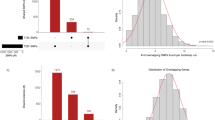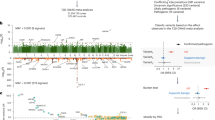Abstract
To search a gene(s) conferring susceptibility to type 2 diabetes mellitus, we genotyped nearly 60,000 gene-based SNPs for Japanese patients and found evidence that the gene at chromosome 6p12 encoding transcription-factor-activating protein 2β (TFAP2B) was a likely candidate in view of significant association of polymorphism in this gene with type 2 diabetes. Extensive analysis of this region identified that several variations within TFAP2B were significantly associated with type 2 diabetes [a variable number of tandem repeat locus: χ2=10.9, P=0.0009; odds ratio=1.57, 95% CI 1.20–2.06, intron 1+774 (G/T); χ2=11.6, P=0.0006; odds ratio=1.60, 95% CI 1.22–2.09, intron 1+2093 (A/C); χ2=12.2, P=0.0004; odds ratio=1.61, 95% CI 1.23–2.11]. The association of TFAP2B with type 2 diabetes was also observed in the UK population. These results suggest that TFAP2B might be a new candidate for conferring susceptibility to type 2 diabetes and contribute to the pathogenesis of type 2 diabetes.
Similar content being viewed by others
Log in or create a free account to read this content
Gain free access to this article, as well as selected content from this journal and more on nature.com
or
References
Altshuler D, Hirschhorn JN, Klannemark M, Lindgren CM, Vohl MC, Nemesh J, Lane CR, Schaffner SF, Bolk S, Brewer C, Tuomi T, Gaudet D, Hudson TJ, Daly M, Groop L, Lander ES (2000) The common PPARγ Pro12Ala polymorphism is associated with decreased risk of type 2 diabetes. Nat Genet 26:76–80
Bengra C, Mifflin TE, Khripin Y, Manunta P, Williams SM, Jose PA, Felder RA (2002) Genotyping of essential hypertension single-nucleotide polymorphisms by a homogeneous PCR method with universal energy transfer primers. Clin Chem 48:2131–2140
Cordell HJ, Clayton DG (2002) A unified stepwise regression procedure for evaluating the relative effects of polymorphisms within a gene using case/control or family data: application to HLA in type 1 diabetes. Am J Hum Genet 70:124–141
Daly MJ, Rioux JD, Schaffner SF, Hudson TJ, Lander ES (2001) High-resolution haplotype structure in the human genome. Nat Genet 29:229–232
Excoffier L, Slatkin M (1995) Maximum-likelihood estimation of molecular haplotype frequencies in a diploid population. Mol Biol Evol 12:921–927
Fajans SS, Bell GI, Polonsky KS (2001) Molecular mechanisms and clinical pathophysiology of maturity-onset diabetes of the young. N Engl J Med 345:971–980
Groves CJ, Wiltshire S, Smedley D, Owen KR, Frayling TM, Walker M, Hitman GA, Levy JC, O’Rahilly S, Menzel S, Hattersley AT, McCarthy MI (2003) Association and haplotype analysis of the insulin-degrading enzyme (IDE) gene, a strong positional and biological candidate for type 2 diabetes susceptibility. Diabetes 52:1300–1305
Haga H, Yamada R, Ohnishi Y, Nakamura Y, Tanaka T (2002) Gene-based SNP discovery as part of the japanese millennium genome project: identification of 190,562 genetic variations in the human genome. J Hum Genet 47:605–610
Hirakawa M, Tanaka T, Hashimoto Y, Kuroda M, Takagi T, Nakamura Y (2002) JSNP: a database of common gene variations in the japanese population. Nucleic Acids Res 30:158–162
Horikawa Y, Oda N, Cox NJ, Li X, Orho-Melander M, Hara M, Hinokio Y et al (2000) Genetic variation in the gene encoding calpain-10 is associated with type 2 diabetes mellitus. Nat Genet 26:163–175
International Human Genome Sequencing Consortium (2001) Initial sequencing and the analysis of human genome. Nature 409:860–921
Isse N, Ogawa Y, Tamura N, Masuzaki H, Mori K, Okazaki T, Satoh N, Shigemoto M, Yoshimasa Y, Nishi S, Hosoda K, Inazawa J, Nakao K (1995) Structural oganization and chromosomal assignment of the human obese gene. J Biol Chem 270:27728–27733
Kadowaki T, Kadowaki H, Mori Y, Tobe K, Sakuta R, Suzuki Y, Tanabe Y, Sakura H, Awata T, Goto Y, Hayakawa T, Matsuoka K, Kawamori R, Kamada T, Horai S, Nonaka I, Hagura R, Akanuma Y, Yazaki Y (1994) A subtype of diabetes mellitus associated with a mutation of mitochondrial DNA. N Engl J Med 330:962–968
Kahn BB (1998) Type 2 diabetes: when insulin secretion fails to compensate for insulin resistance. Cell 92:593–596
Kroeger KM, Abraham LJ (1996) Identification of an AP-2 element in the −323 to −285 region of the TNF-alpha gene. Biochem Mol Biol Int 40:43–51
Matsumoto M, Nishimura T (1998) Mersenne twister: a 623-dimensionally equidistributed uniform pseudo-random number generator. ACM Trans Model Comput Simul 8:3–30
Matsuzawa Y, Funahashi T, Nakamura T (1999) Molecular mechanism of metabolic syndrome X: contribution of adipocytokines, adipocyte-derived bioactive substances. Ann NY Acad Sci 892:146–154
Moser M, Imhof A, Pscherer A, Bauer R, Amselgruber W, Sinowatz F, Hofstadter F, Schule R, Buettner R (1995) Cloning and characterization of a second AP-2 transcription factor: AP-2β. Development 121:2779–2788
Moser M, Pscherer A, Roth C, Becker J, Mucher G, Zerres K, Dixkens C, Weis J, Guay-Woodford L, Buettner R, Reinhard Fassler (1997) Enhanced apoptotic cell death of renal epithelial cells in mice lacking transcription factor AP-2β. Genes Dev 11:1938–1948
Ohnishi Y, Tanaka T, Ozaki K, Yamada R, Suzuki H, Nakamura Y (2001) A high-throughput SNP typing system for genome-wide association studies. J Hum Genet 46:471–477
Ong KKL, Phillips DI, Fall C, Poulton J, Bennett ST, Golding J, Todd JA, Dunger DB (1999) The insulin gene VNTR, type 2 diabetes and birth weight. Nat Genet 21:262–263
Ozaki K, Ohnishi Y, Iida A, Sekine A, Yamada R, Tsunoda T, Sato H, Sato H, Hori M, Nakamura Y, Tanaka T (2002) Functional SNPs in the lymphotoxin-α gene that are associated with susceptibility to myocardial infarction. Nat Genet 32:650–654
Saito S, Iida A, Sekine A, Miura Y, Sakamoto T, Ogawa C, Kawauchi S, Higuchi S, Nakamura Y (2001) Identification of 197 genetic variations in six human methyltransferase genes in the Japanese population. J Hum Genet 46:529–537
Saltiel AR (2001) New perspectives into the molecular pathogenesis and treatment of type 2 diabetes. Cell 104:517–529
Satoda M, Zhao F, Diaz GA, Burn J, Goodship J, Davidson HR, Pierpont ME, Gelb BD (2000) Mutation in TFAP2B cause Char syndrome, a familial form of patent ductus arteriosus. Nat Genet 25:42–46
Seki T, Tanaka T, Nakamura Y (2000) Genomic structure and multiple single-nucleotide polymorphisms (SNPs) of the thiopurine S-methyltransferase (TPMT) gene. J Hum Genet 45:299–302
Spiegelman BM, Flier JS (1996) Adipogenesis and Obesity: Rounding out the big picture. Cell 87:377–389
Suzuki A, Yamada R, Chang X, Tokuhiro S, Sawada T, Suzuki M, Nagasaki M, Nakayama-Hamada M, Kawaida R, Ono M, Ohtsuki M, Furukawa H, Yoshino S, Yukioka M, Tohma S, Matsubara T, Wakitani S, Teshima R, Nishioka Y, Sekine A, Iida A, Takahashi A, Tsunoda T, Nakamura Y, Yamamoto K (2003) Functional haplotypes of PADI4, encoding citrullinating enzyme peptidylarginine deiminase 4, are associated with rheumatoid arthritis. Nat Genet 34:395–402
Takahashi M, Arita Y, Yamagata K, Matsukawa Y, Okutomi K, Horie M, Shimomura I, Hotta K, Kuriyama H, Kihara S, Nakamura T, Yamashita S, Funahashi T, Matsuzawa Y (2000) Genomic structure and mutations in adipose-specific gene, adiponectin. Int J Obes 24:861–868
Wiltshire S, Hattersley AT, Hitman GA, Walker M, Levy JC, Sampson M, O’Rahilly S et al (2001) A genomewide scan for loci predisposing to type 2 diabetes in a U.K. population (the Diabetes UK Warren 2 Repository): analysis of 573 pedigrees provides independent replication of a susceptibility locus on chromosome 1q. Am J Hum Genet 69:553–569
Yamada R, Tanaka T, Unoki M, Nagai T, Sawada T, Ohnishi Y, Tsunoda T, Yukioka M, Maeda A, Suzuki, K, Tateishi H, Ochi T, Nakamura Y, Yamamoto K (2001) Association between a single-nucleotide polymorphism in the promoter of the human interleukin-3 gene and rheumatoid arthritis in Japanese patients, and maximum-likelihood estimation of combinational effect that two genetic loci have on susceptibility to the disease. Am J Hum Genet 68:674–685
Zimmet P, Alberti KGMM, Shaw J (2001) Global and societal implications of the diabetes epidemic. Nature 414:782–786
Acknowledgements
We thank Ms. K. Ohashi for her technical assistance and Drs. S. Saito, T. Tanaka, Y. Ohnishi, R. Yamada, S. Ikegawa, A. Takahashi, and K. Hotta for helpful discussions. This work was supported by a grant from the Japanese Millennium Project.
Author information
Authors and Affiliations
Corresponding author
Additional information
Accession numbers and URLs for data in this article are as follows: Genbank, http://www.ncbi.nlm.nih.gov/Genbank/ [for the TFAP2B gene (accession number NT_007592)]. For SNPs and primers, the IMS-JST Japanese SNP database (http://snp.ims.u-tokyo.ac.jp/). Online Mendelian Inheritance in Man (OMIM), http://www.ncbi.nlm.nih.gov/OMIM [for type 2 diabetes (MIM 125853), TFAP2B (MIM 601601), MODY (MIM 606391), Char syndrome (MIM 169100)].
Rights and permissions
About this article
Cite this article
Maeda, S., Tsukada, S., Kanazawa, A. et al. Genetic variations in the gene encoding TFAP2B are associated with type 2 diabetes mellitus. J Hum Genet 50, 283–292 (2005). https://doi.org/10.1007/s10038-005-0253-9
Received:
Accepted:
Published:
Issue date:
DOI: https://doi.org/10.1007/s10038-005-0253-9
Keywords
This article is cited by
-
Integrative analysis of Mendelian randomization and Bayesian colocalization highlights four genes with putative BMI-mediated causal pathways to diabetes
Scientific Reports (2020)
-
Comprehensive analysis of the expression and prognosis for TFAP2 in human lung carcinoma
Genes & Genomics (2020)
-
Association between Transcription Factor AP-2B genotype, obesity, insulin resistance and dietary intake in a longitudinal birth cohort study
International Journal of Obesity (2019)
-
Mutation status coupled with RNA-sequencing data can efficiently identify important non-significantly mutated genes serving as diagnostic biomarkers of endometrial cancer
BMC Bioinformatics (2017)
-
Replication study of the association of rs7578597 in THADA, rs10886471 in GRK5, and rs7403531 in RASGRP1 with susceptibility to type 2 diabetes among a Japanese population
Diabetology International (2015)



